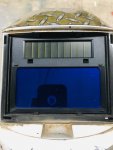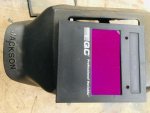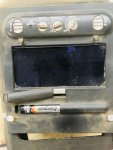bd,
My Lincoln and my HF helmets use standard mercury cell watch batteries, which are not rechargeable. On those helmets, there would be no point in a charging circuit because the batteries are non-rechargeable. You would think that if they were rechargeable, they would have been fitted with rechargeable batteries from the factory. On both of these helmets, the solar sensor is a type tuned to the high UV temps encountered in welding. Both will darken in bright sunlight and when grinding if not in the "GRINDING" mode.
The reason I am trying to get the word out is, last Spring when I started a project, I had not used my Lincoln helmet in a few months. It worked perfectly when I put it away. I struck my first arc and realized my helmet never darkened. I ended up with a flash burn on my right retina. Thankfully I was welding on really low power at the time.
Thankfully, that injury has nearly healed but, it was no fun for the six months I had a spot in my vision. That is when I started researching auto darkening helmets. The Lincoln owners manual warns the user to always use the test feature to make sure the battery is good. I do that religiously now, as well as proactively changing my battery annually. The HF helmet is very very vague in any mention of the battery, other than saying "It SHOULD last four or five years." It has no test feature and your first clue the battery is toast is when it fails. Not good.
Your eyes are precious. Without them, doing anything becomes a lot harder. The get plenty cranky with normal age. No need to beat them up like I did.
Just a word of caution...
Cave Creek, first let me say that I did not intend to step on anyone's toes, but only to clear up/explain that there are basically two types of photo cells and the statements made previously leave a cloudy perception of what does what on an auto darkening helmet. After all, the more people know, the better judgements they can make on purchasing/maintaining that critical piece of protective gear. So I responded for the sake of everyone interested. I took pictures of two of my helmets that will illustrate what I tried to explain earlier.
First; Here's a nice little tutorial on the two basic types of light sensors and their applications:
https://www.electronics-tutorials.ws/io/io_4.html
The tutorial basically says photoelectric devices can be grouped into two main categories. One generates a DC output. The other changes its electrical characteristics and acts like a switch.
First type: Photo-voltaic Cells; These photodevices generate an emf (voltage) in proportion to the radiant light energy received. The most common type of photovoltaic light sensor is the Solar Cell. Solar cells convert light energy directly into DC electrical energy in the form of a voltage or current to power a resistive load. Then photovoltaic cells are similar in many ways to a battery because they supply DC power.
Second type: Photo-junction Devices; These photodevices are mainly true semiconductor devices such as the photodiode or phototransistor which use light to control the flow of electrons and holes across their PN-junction. Photojunction devices are specifically designed for detector application (sensing) and light penetration with their spectral response tuned to the wavelength of incident light. Photo diodes fall into this latter category. Photodiodes are very versatile light sensors that can turn its current flow both ON and OFF in nanoseconds. (These are what do the highspeed switching for the auto darkening feature on the helmets.)
I previously did not say that the solar cells are there for recharging batteries. They are there to AID the batteries and prolong their use. Although there may be rechargeable batteries in the newer helmets. I don't know. Mine are older versions: A Jackson and a Millermatic. For the pics I have removed the clear plastic shields so one can see the two types of photo cells.
Not sure why the photos aren't inserted properly but do follow correctly from left to right.
First up is the Millermatic that has both the Photovoltaic cells (solar cells) that are used to aid the battery voltage and the Photo Diode cells that do the actual sensing of the arc and switch on the auto darkening (in nano seconds to protect the eyes). You'll see the solar cells across and above the viewing area. You'll see two Photo Diode cells beneath the solar cells at opposite corners and behind two small square holes. There's two so that if one fails the other will still do the switching.
Here's a pic of the control panel for this helmet. The small button cell battery is inside the panel. Rechargeable? Not sure but the first thing I do when picking up the helmet is to turn it on and test it. If it doesn't auto darken, I don't use it but put it outside in the sun for a day or more and use the other helmet. But even rechargeable batteries go bad over time so at some point I'll have to dig into it or trash it. This control panel is sealed up.
My second helmet, the Jackson, also an auto darkening helmet but without the solar cells. But notice it does have the two photo diodes for sensing and again, they're what does the highspeed switching to save your eyes. (Not the solar cells)
Here's the control panel: Notice the batteries in this one. Two AAA batteries for power. Why? With no photovoltaic (solar) cells to aid the battery's voltage, much larger batteries are needed to keep power to the auto darkening sensor circuit. If this type of helmet only had button cells your actual welding time would be drastically less. Again, with this helmet, the power on button is also the test button and should be the first thing on one's mind when you pick it up. Especially if it hasn't been used for a while.
I'm sure there's advances in the newer helmets. I'm tempted to buy one just for the larger viewing area. The newer ones also seem to become clearer when in the off mode when not welding. One important factor to note with either style helmet is to keep the lens shield clean! Especially the area around the photo detectors! As a dirty shield can lead to faulty switching of the auto darkening. I agree with you in that one's eyes are extremely precious!
So, there you have my version of the two types of photo cells as used in these helmets. Is one better than the other? Don't know. Maybe a professional welder would have a preference. Otherwise it's ones personal choice. But the two types of photo cells aren't like tissue paper and Kleenex. They are two distinctive types for two distinctive purposes. And that's what I wanted to point out. Hope this helps to explain some of what does what when you look at the helmet that you do have. There's many different types and options. Now, everybody go change your batteries and then make sure your protective shield is clean and scratch free! Especially over the photo diodes!! (located behind the little holes)

Regards,
David






